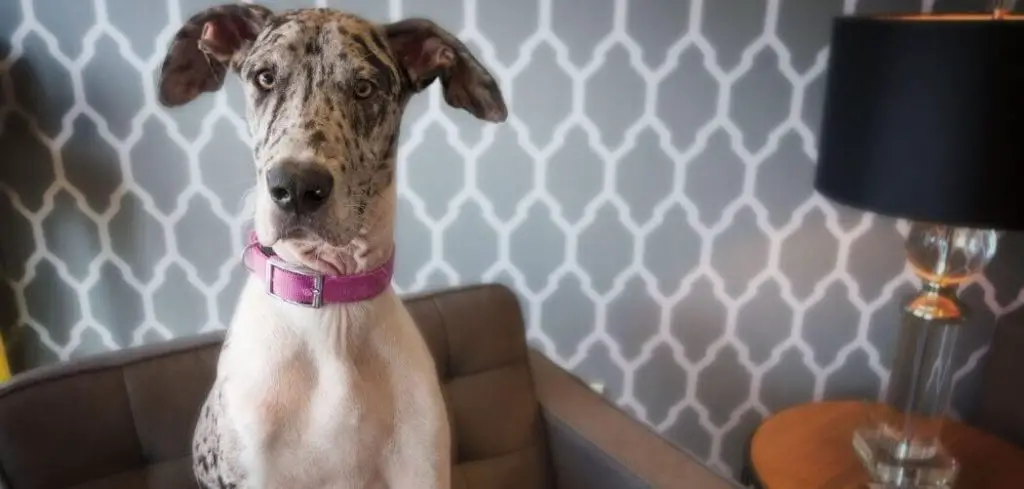Seeing your dog panting in a cool, air-conditioned room can be unsettling. It may seem counterintuitive—after all, your dog should be comfortable in a cooled environment, right?
We outline the common reasons why a dog may pant in air conditioning, what you can do at home, and when to seek veterinary help.
Dog Panting in Air Conditioning — Why It Happens
Dogs may pant in air conditioning due to pain, anxiety, medication side effects, heart problems, or respiratory disease.
Even though the temperature feels comfortable to you, your dog might be experiencing internal discomfort that has nothing to do with the external environment.
Anxiety, overheating from earlier exposure, or an underlying health condition can all trigger panting regardless of a cooled room.

Dog Panting in Air Conditioning: Common Causes
Anxiety or Stress
Dogs may pant even in a cool environment if they are experiencing anxiety.
Triggers such as separation, thunderstorms, or unfamiliar guests can lead to restlessness and heavy breathing.
Panting is a common physiological response to stress and can persist long after the trigger has disappeared.
In the context of air conditioning, your dog might be reacting to unfamiliar sounds, changes in environment, or even fear of being alone.
Pain or Discomfort
Pain is a major driver of unexplained panting.
Whether it’s arthritis, dental disease, or abdominal discomfort, pain triggers panting due to increased stress and physical strain.
Because dogs often hide their pain, panting in an otherwise calm and cool space may be one of the only visible clues.
Panting from pain tends to occur at rest and doesn’t go away even when your dog lies down.
Related: Dog panting excessively (Causes and What To Do)
Heart Disease
When a dog’s heart isn’t pumping efficiently, the body may struggle to deliver enough oxygen.
Panting is the body’s way of compensating—trying to get more oxygen into the bloodstream.
Heart disease can also cause fluid to build up in the lungs, which leads to labored breathing.
If your dog is panting heavily in a cool environment, especially if they’re older or showing signs like fatigue or coughing, heart issues could be the cause.
Respiratory Illness
Conditions like bronchitis, collapsing trachea, or laryngeal paralysis can cause breathing difficulty.
These issues make it hard for your dog to draw in enough air, leading to panting that may not be tied to heat at all.
Even in a climate-controlled room, your dog may continue to pant to cope with oxygen demand.
In some cases, the cool dry air can even irritate the airways further, worsening the panting.
Side Effects of Medication
Steroids (like prednisone) and certain pain medications can cause increased panting as a side effect.
These drugs affect the metabolism, increase thirst, and can make dogs feel restless or overheated from the inside.
If your dog recently started a new medication and is panting more—even in air conditioning—consult your vet.
Lingering Heat Exposure
If your dog was recently outdoors or in a warm area, they may still be cooling down.
Panting can continue long after they’ve re-entered a cool space.
This is especially true for brachycephalic (flat-faced) breeds like Bulldogs and Pugs, who struggle to regulate body temperature.
Panting in air conditioning may reflect a delayed recovery from mild heat exhaustion.
What to Do If Your Dog Is Panting in Air Conditioning
First, observe your dog closely. Are they otherwise acting normal—eating, drinking, and responding to you?
If they seem anxious, try calming techniques: sit with them, play soothing music, or offer a comfort item like a favorite toy or blanket.
Check if they might be in pain. Gently examine their body for signs of injury or discomfort, but stop if they resist or show signs of distress.
Ensure the air conditioning isn’t blowing directly on them, as some dogs dislike cold air hitting their face or body.
Make sure they have access to fresh water and a comfortable resting spot. If panting continues beyond 30–60 minutes or worsens, it’s time to consult a vet.
When to Call or Visit Your Vet
Seek veterinary care promptly if your dog:
Panting is accompanied by coughing, gagging, or labored breathing.
Shows signs of lethargy, collapse, or won’t eat or drink.
Has pale, bluish, or bright red gums (indicating oxygen or circulation issues).
Was recently exposed to high heat or left in a car or hot room.
Has underlying conditions like heart disease or is on medications.
Your vet may recommend diagnostic tests such as chest x-rays, blood work, or ultrasound to determine the cause.
Read more: Dog Panting and Having Accidents (Is this something serious?)
Key Takeaway
Panting in air conditioning may seem harmless, but it can signal discomfort, stress, or serious medical issues.
If your dog continues to pant in a cool room, take note of their behavior, environment, and any other symptoms.
Many cases can be managed with simple care or a quick vet check—but if you’re ever unsure, it’s best to call your veterinarian.
Your dog’s breathing is one of the clearest indicators of their internal health—don’t ignore what it’s trying to tell you.
